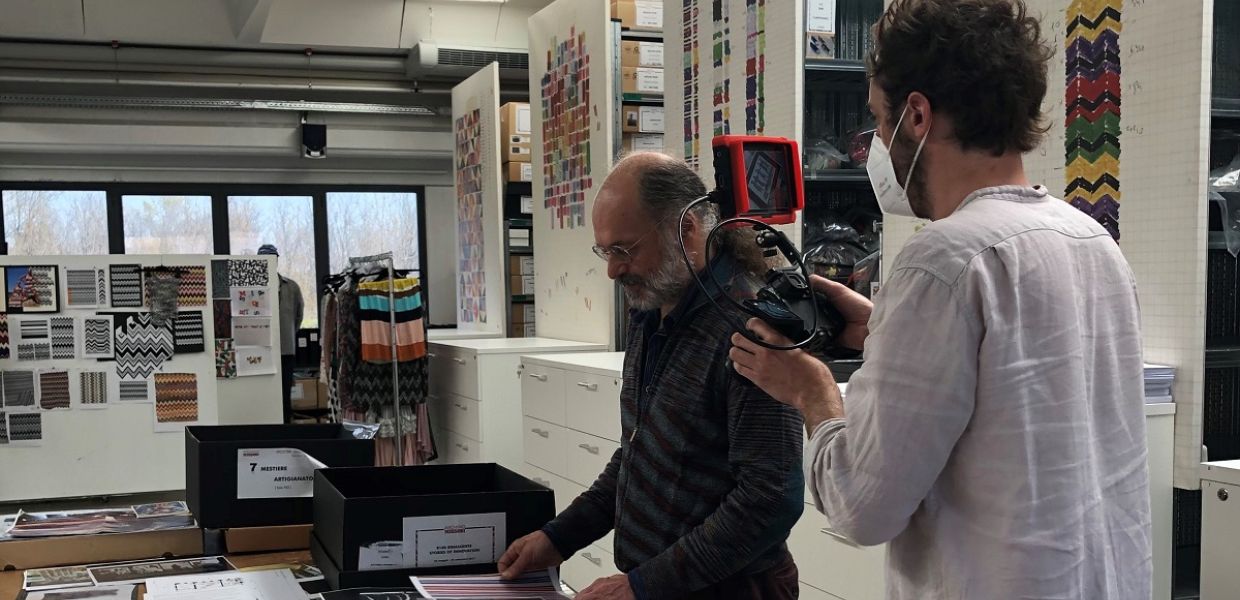The ‘non-commercial’ use prohibited by copyright labels attached to many a video and audio fragment urged the creative team to review the content selection repeatedly. In some cases, extensive negotiations with rights holders ensued and multiple-option-scenarios were drawn up to allow the team to deal with all possible outcomes. As for the vlogs, even videos out of copyright and labelled as CC0/Public Domain often weren’t downloadable. Jens Kösters of TIB, who took on the video editing, stumbled upon several such cases. Result: the writing team had to reignite its hunt for content and rewrite the scripts.
The issue of copyright arose again in a series (True Colours #1, 2 and 3) unfolding the story of the iconic fashion brand Missoni, whose artistic director Luca Missoni stepped forward as an Ambassador of Change for the Europeana XX project. Missoni was followed and interviewed in the company office, archive and production unit, resulting in many hours of brand-new footage. Yet Anna Carniel, who coordinated the production for European Fashion Heritage Association (EFHA), found that additional archival content was needed. ‘For that we had to diligently clear the rights, as a deep respect for the history of the Missoni brand and the family was always our vantage point’.
Layer cake
The storytelling formats we chose - in all cases multi-layered with the aim of attracting various target audiences - posed challenges as well. ‘I think it would have been easier if I had interviewed one person instead of three,’ says Sasha Goldstein Sabbah, digital curator at Jewish Cultural Quarter, who worked on one of the podcast episodes. ‘I also found the creation of the narrative part challenging: writing the script is fine but to record and edit oneself is difficult.’
The editing process, indeed, is challenging: stitching video fragments together into a dynamic compilation with well-paced subtitles and intro/outro slides, or moulding a podcast episode out of narration, interviews and AV-content is time-consuming and requires a plethora of editorial decisions.
The phased process of researching, sourcing and clearing content, script writing, interviewing, recording, editing, branding, contextualising, publishing and promoting the editorials proved to be even more daunting in this particular project’s context, as every step required the involvement of different teams at different partner institutions. ‘Working with a big team, even multiple separate teams, all based at home, is very different from my usual routine, where I perform all the tasks involved myself,’ confirms podcast producer Caspar Stalenhoef.
(Pod)casting on
That’s why, in podcast series 2, we’ll take a more focused approach involving scripting and recording by Caspar and myself. This time, we will be interviewing authors of Europeana XX blog posts, investigating the complementarity of the written and the spoken word. We’re eager to add an extra dimension, more depth and a personal flavour to the sort of stories Europeana visitors know so well.
Despite the struggles and hurdles, XX-curators and editors are enthused about the experience. ‘I really enjoyed the mixture of media,’ Sasha Goldstein-Sabbah agrees, ‘as well as sourcing documents and images in Europeana, and then interviewing experts about the story they convey’. Seeing the concept come to life through the collections we hold so dear, is a fascinating and rewarding experience indeed.
All our podcast and vlog episodes are available to be reused and the Century of Change podcast and Story Flix vlog series will be expanded with new episodes. So please explore them all on our 20th Century feature page, or - why not? - try creating dynamic editorials yourself. Easier said than done, admittedly, but where there’s a will, there’s a way.



.png)